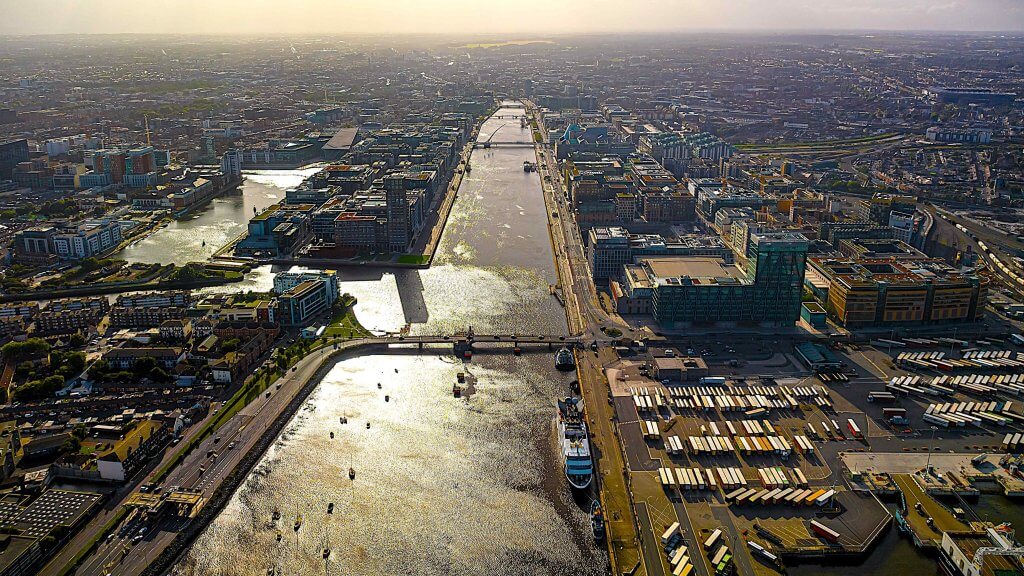Dublin Port’s €1.1 Billion Revamp: Innovative New Bridge To ‘Redefine City’s Skyline’

Dublin Port’s ambitious €1.1 billion Masterplan 2040 is set to reach a pivotal milestone with the proposed addition of a striking new bridge designed by Cowi, Moxon, and RPS.
The single-leaf bascule bridge, destined to span the River Liffey, promises to be both a functional infrastructure marvel and a new landmark for the city.
The innovative bridge design features a distinctive opening mechanism involving a reconstituted granite counterweight, which will be supported by two reclining steel arms on separate pivots.
The approach allows for a “choreographed opening sequence,” where the counterweight’s arms align seamlessly with the bridge beams, reducing energy use and carbon emissions. By separating the pivots, the design improves efficiency compared to traditional bascule bridges.
The bridge will align with the existing 30.5-meter-wide navigation channel, facilitating uninterrupted passage for large vessels. Additionally, a 20.5-meter-wide channel will accommodate local maritime traffic, preserving alignment with the nearby Tom Clarke Bridge’s piers.
Integral to the Southern Port Access Route (Spar), this bridge will also enhance the 7-kilometer network of cycle and pedestrian routes across the Poolbeg Peninsula and the River Liffey. By channeling port traffic away from public roads, it will alleviate congestion on the Tom Clarke Bridge and create a new urban landmark.
The bridge’s design includes dedicated lanes for pedestrians and cyclists, separated from vehicle traffic by upstand structural beams. This feature not only contributes to the bridge’s sleek profile but also ensures safety. The primary active travel route on the eastern side will offer panoramic sea views, while the secondary route might later accommodate Dublin’s Luas tram system.
As the easternmost road bridge over the River Liffey, the new crossing will facilitate swift container transport from the port to a nearby rail facility, enhancing logistical efficiency.
This bridge is a key component of the Third and Final Masterplan (3FM) project, the final phase of Dublin Port’s Masterplan 2040. The 15-year scheme is designed to bolster port capacity, bridging the northern and southern halves of the port and meeting increasing cargo and freight demands between Continental Europe and Ireland.
Formal consultations for the project are expected to conclude in September 2024, with construction slated to begin in the late 2020s and the bridge expected to be completed by the late 2030s.
Moxon associate Richard Thebridge said: “We are excited to collaborate with Cowi on our debut project in Dublin. The Spar Bridge will play a crucial role in this rapidly developing area, enhancing active travel connections and providing new vistas of the port. Our design not only reduces carbon emissions but also introduces a bold new landmark.”
Cowi UK Project Director Oliver Stross added, “Cowi is thrilled to contribute to the 3FM project, which will significantly expand Dublin Port’s capacity. The Spar Bridge will optimize land use on the Poolbeg Peninsula and ease traffic on the Tom Clarke Bridge, benefiting the broader Dublin transport network. Our innovative opening mechanism minimizes carbon emissions over the bridge’s lifecycle.”
Barry O’Connell, CEO of Dublin Port Company, highlighted the broader impact: “The 3FM project is crucial for supporting Ireland’s future export ambitions. For the local community, it promises enhanced public amenities, including a Maritime Village, a 7-kilometer network of pedestrian and cycle routes, a new public park, a wildflower meadow, and a floodlit playing pitch. We deeply appreciate all contributors to this transformative plan for the port, the city, and its residents.”




